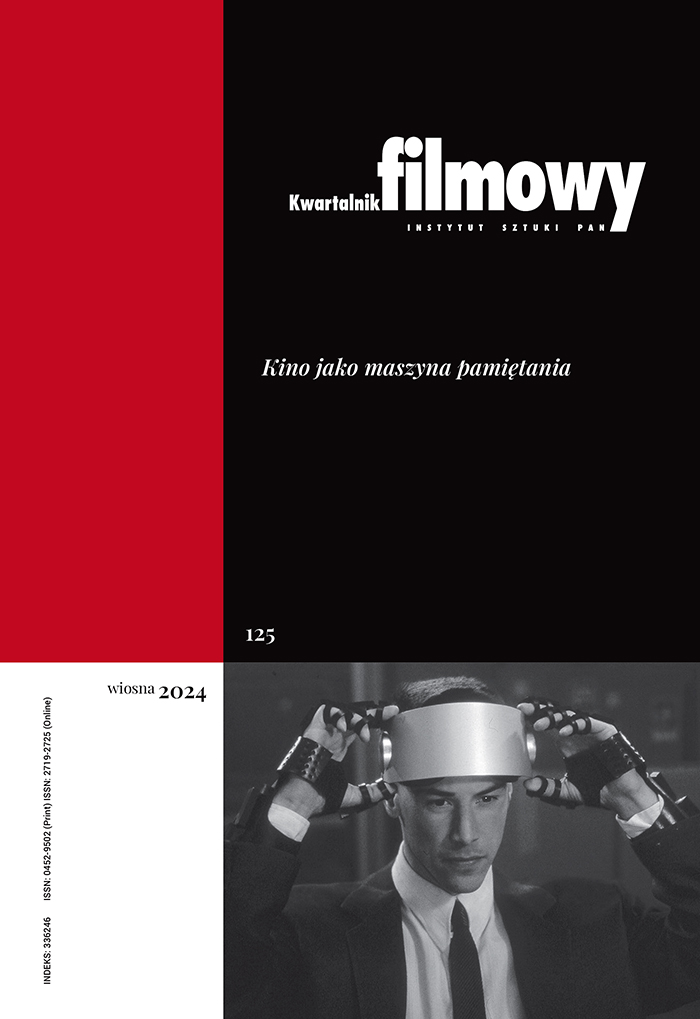Interpretation as Succour for Narration: The Case of Luis Bunuel’s “That Obscure Object of Desire”
Abstract
The compositional manipulations (literary, film and theatrical) that disturb linearity of the story can be removed in procedures that order the reception of the film. The reader or viewer can put his or her own story in the “right” order - using the logic applied in solving a riddle. However when the disturbance does not lead to the mixing of elements of the story or obscuring information, but is there to introduce disorder and lack of agreement inside the story, the receptive combination often proves to be insufficient. Therefore, in order to organize the narrative one needs to apply interpretation. Jakubowski demonstrates this using the example of Luis Bunuel’s That Obscure Object of Desire, a film in which the director asked two different actresses to play the lead female role.
Keywords:
Luisa Buñuel, narrative, interpretationReferences
Buñuel Luis, Kino – instrument poezji, tłum. J. Skórnicka, „Literatura na Świecie” 2000, nr 7-8, s. 52.
Google Scholar
Buñuel Luis., Ostatnie tchnienie... tłum. M. Braunstein, Warszawa 1989, s. 16, 46, 168, 242.
Google Scholar
Caillois Roger, Powieść kryminalna, czyli jak intelekt opuszcza świat, aby oddać się li tylko grze, i jak społeczeństwo wprowadza z powrotem swe problemy w igraszki umysłu, tłum. J. Błoński, w: Roger Caillois, Odpowiedzialność i styl. Eseje, Warszawa 1967.
Google Scholar
Delain Michel, Tajemniczy Don Luis, „Film” 1977, nr 39, s. 21.
Google Scholar
Drouzy Maurice, Luis Bunuel Architecte do Reve, Paris 1978, s. 297.
Google Scholar
Ghillebaert Françoise, The double in Bunuel’s „That Obscure Object of Desire”, „Post Script”, 22.06.2003.
Google Scholar
Górzański Jerzy, Lepiej oblać wodą niż zabić”, „Film” 1979, nr 14, s. 9.
Google Scholar
Kolasińska-Pasterczyk Iwona, Piekła Luisa Bunuela. Wokół problematyki sacrum i profanum, Kraków 2007, s. 28, 31.
Google Scholar
Kołodyński Andrzej, Mroczny przedmiot pożądania, „Film” 1977, nr 14, s. 9.
Google Scholar
Kovács Katherine Singer, Luis Bunuel and Pierre Louys: Two Visions of Obscure Objects, „Ciemna Journal” (USA) 1979, nr 1 (19), s. 92- 94.
DOI: https://doi.org/10.2307/1225422
Google Scholar
Królikiewicz Grzegorz, Ostatni sen Bunuela. Próba analizy filmu „Mroczny przedmiot pożądania”, Łódź 1994, s. 62-63, 95.
Google Scholar
Królikowska Elżbieta, Śladami Bunuela. Kino hiszpańskie, Warszawa 1998, s. 100, 110.
Google Scholar
Louÿs Pierre, Kobieta i pajac, tłum. J. Mareshowa, Warszawa 1921, s. 30.
Google Scholar
Maleszyński Dariusz Cezary, Motyw dublera w filmie Luisa Bunuela „Mroczny przedmiot pożądania”, w: Z zagadnień stylu i kompozycji w filmie współczesnym, red. M. Hendrykowski, Poznań 1982, s. 30-31, 38.
Google Scholar
Osadnik Wacław, Poetyka filmów Luisa Bunuela (próba analizy tekstowej), „Film” 1977, nr 38, s. 20-21.
Google Scholar
Ricoeur Paul, Czas i opowieść, t. 1: Intryga i historyczna opowieść, tłum. M. Frankiewicz, Kraków 2008, s. 83.
Google Scholar
Sartre Jean-Paul, Czasowość u Faulknera. Refleksje nad „The Sound and the Fury”, w: Sartre Jean-Paul, Czym jest literatura? Wybór szkiców krytycznoliterackich, wyb. A. Tatarkiewicz, tłum. J. Lalewicz, Warszawa 1968, s. 97-98.
Google Scholar
Authors
Piotr Jakubowskikwartalnik.filmowy@ispan.pl
Adam Mickiewicz University, Poznań Poland
Doktorant w Zakładzie Semiotyki Kultury Instytutu Kulturoznawstwa UAM. Zajmuje się egzystencjalnym i politycznym wymiarem narracji.
Statistics
Abstract views: 183PDF downloads: 131
License
Copyright (c) 2010 Piotr Jakubowski

This work is licensed under a Creative Commons Attribution 4.0 International License.
The author grants the publisher a royalty-free non-exclusive licence (CC BY 4.0) to use the article in Kwartalnik Filmowy, retains full copyright, and agrees to identify the work as first having been published in Kwartalnik Filmowy should it be published or used again (download licence agreement). The journal is published under the CC BY 4.0 licence. By submitting an article, the author agrees to make it available under this licence.
In issues from 105-106 (2019) to 119 (2022) all articles were published under the CC BY-NC-ND 4.0 licence. During this period the authors granted a royalty-free non-exclusive licence (CC BY-ND 4.0) to use their article in „Kwartalnik Filmowy”, retained full copyright, and agreed to identify the work as first having been published in our journal should it be published or used again.
Most read articles by the same author(s)
- Piotr Jakubowski, In Search of “Third Sense”: Film Image in Theory (and Practice) of Andrei Tarkovsky - A Contribution to Aesthetics of Roland Barthes , Kwartalnik Filmowy: No. 64 (2008): Film Image, Image in Film (part I)











